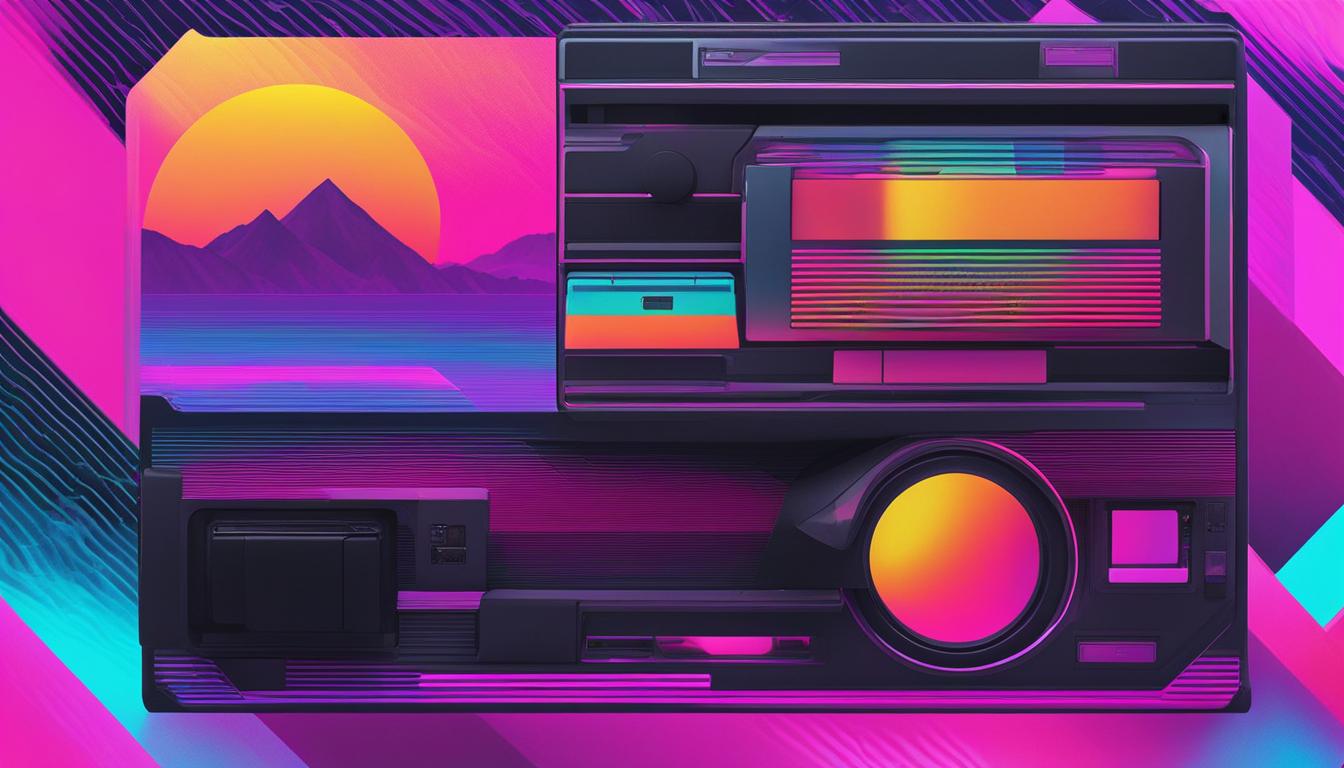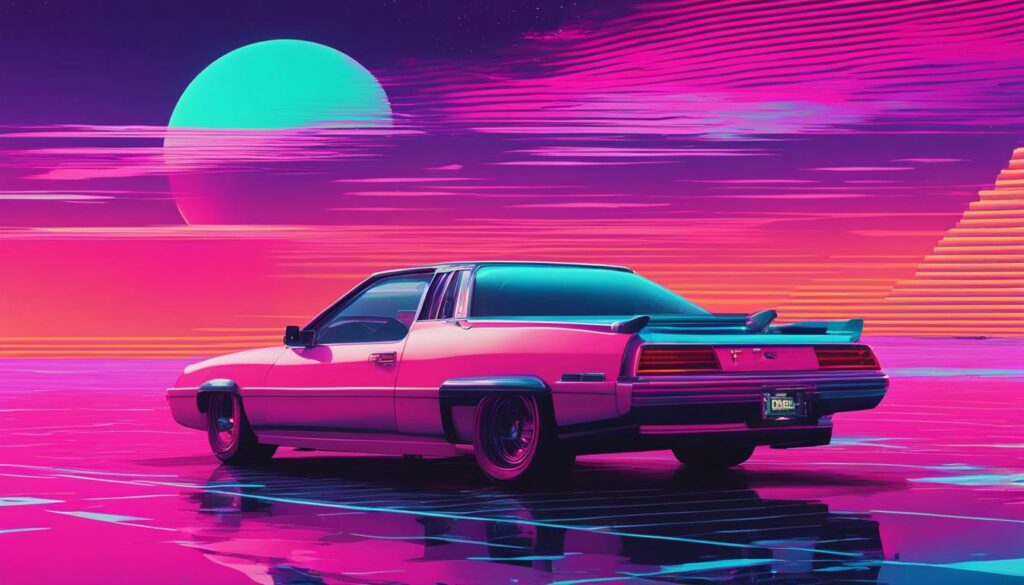No products in the cart.

Welcome to our in-depth exploration of vaporwave and synthwave, two distinct music genres that have captivated music enthusiasts around the world. In this article, we will compare and contrast these genres, examining their origins, sound, and unique characteristics. Whether you’re a fan of vaporwave or synthwave, or simply curious about these music styles, join us as we dive into the fascinating world of vaporwave and synthwave.
In this section, we will delve into the fascinating origins of vaporwave and synthwave. These two unique music genres emerged in the early 2010s, albeit with different influences and cultural contexts.
Vaporwave originated as an internet-based subculture, drawing inspiration from 80s and 90s consumer culture, smooth jazz, and elevator music. The genre was born out of a desire to create nostalgic and surreal soundscapes, often characterized by slowed-down, chopped-up samples of 80s pop songs, corporate jingles, and Muzak.
Vaporwave gained recognition through platforms like Bandcamp and SoundCloud, where artists like Macintosh Plus (aka Vektroid) and Blank Banshee contributed to its development. These early pioneers combined influences from experimental music, glitch art, and visual aesthetics to create a distinct and subversive genre that challenged traditional notions of music production and consumption.
On the other hand, synthwave draws its roots from the nostalgic sounds of 80s pop, new wave, and electronic music. This genre seeks to capture the essence of the 80s era, evoking a sense of retro-futurism and nostalgia. Synthwave artists utilize synthesizers, drum machines, and powerful bass lines to create a distinctively 80s sound.
While synthwave has origins in the 2000s, it gained widespread popularity in the early 2010s with the release of the iconic soundtrack for the film Drive. Artists like Kavinsky and The Weeknd embraced the synthwave sound, introducing it to a broader audience and solidifying its place within popular culture.
| Vaporwave | Synthwave |
|---|---|
| Originated as an internet-based subculture | Rooted in 80s pop, new wave, and electronic music |
| Influenced by 80s and 90s consumer culture, smooth jazz, and elevator music | Evokes retro-futurism and nostalgia for the 80s era |
| Pioneered by artists like Macintosh Plus and Blank Banshee | Popularized by artists like Kavinsky and The Weeknd |
“Vaporwave and synthwave are unique genres that emerged in the early 2010s, each with its own distinct origins and influences. While vaporwave explored nostalgia and surreal soundscapes inspired by 80s and 90s consumer culture, synthwave sought to capture the essence of the 80s era through its nostalgic and retro-futuristic sounds. Both genres have made significant contributions to popular culture and continue to inspire artists and musicians today.”
When comparing vaporwave and synthwave, it becomes apparent that these two music genres have distinct characteristics that set them apart. Vaporwave, known for its experimental and psychedelic sound, contrasts with the nostalgic and synth-driven melodies of synthwave.
Vaporwave Characteristics: Vaporwave often incorporates samples from older songs and music, creating a collage-like effect. This genre is known for its dreamy and lo-fi soundscapes, which can be described as slowed-down and distorted versions of existing tracks. Vaporwave also tends to incorporate elements of social commentary, utilizing nostalgic consumerist imagery and glitchy effects to critique consumer culture.
Synthwave Characteristics: Synthwave, on the other hand, draws inspiration from the 80s synth and drum machine sounds, paying homage to the music of that era. This genre is characterized by its upbeat melodies and retro-futuristic aesthetic. Synthwave often features pulsing basslines, driving beats, and catchy hooks, creating an energetic and nostalgic listening experience.
While both vaporwave and synthwave share a love for nostalgia, they explore it in different ways. Vaporwave delves into the surreal and abstract, utilizing glitch art and distorted visuals, while synthwave embraces the neon lights and sleek visuals of the 80s.
| Vaporwave | Synthwave |
|---|---|
| Experimental and psychedelic sound | Nostalgic and synth-driven melodies |
| Slowed-down and distorted versions of existing tracks | Inspired by 80s synth and drum machine sounds |
| Incorporates social commentary and glitchy effects | Embraces retro-futuristic aesthetic and catchy hooks |
| Utilizes surreal and abstract visuals | Embraces neon lights and sleek visuals |
In summary, while both vaporwave and synthwave share common themes of nostalgia, they differ in their soundscapes, instrumentation, and visual aesthetics. Vaporwave offers a trippy and introspective experience with its experimental and social commentary-driven approach, while synthwave delivers an energetic and nostalgic journey back to the 80s with its upbeat melodies and retro-futuristic visuals.
While vaporwave and synthwave are distinct music genres with their own unique characteristics, they also share some commonalities that have contributed to their popularity and influence in the music industry. Let’s explore some of the similarities between these two genres.
Vaporwave and synthwave both draw inspiration from the aesthetics of the 80s, embracing the visual and auditory elements that defined this era. Both genres pay homage to the neon lights, retro-futuristic imagery, and nostalgia associated with the 80s. Whether it’s the vibrant colors, the iconic fashion, or the synthesized sounds, both genres transport listeners back in time and evoke a sense of longing for the past.
Both vaporwave and synthwave offer unique perspectives on consumerism, nostalgia, and the cultural impact of the past. Vaporwave often incorporates samples from popular 80s and 90s music, advertisements, and television shows, creating a sense of ironic nostalgia and social commentary. Synthwave, on the other hand, with its nostalgic synth and drum machine sounds, creates a dreamlike atmosphere that transports listeners to a nostalgic realm.
Vaporwave and synthwave celebrate and critique the bygone eras of the 80s and 90s, offering listeners a mix of nostalgia and cultural commentary.
Both genres have made an impact on popular culture, finding their way into films, TV shows, music videos, and even meme culture. Synthwave has been prominently featured in movies like Drive and TV series like Stranger Things, while vaporwave has a strong presence in music videos and online platforms due to its unique and captivating visuals. Their ability to tap into the collective nostalgia of a generation has made them a significant force in modern entertainment.
While there are notable differences between vaporwave and synthwave, the similarities between these genres make them both compelling and fascinating for music lovers. Their nostalgic appeal, cultural critique, and visual aesthetics have contributed to their enduring popularity and influence in the music industry.

The influence of both vaporwave and synthwave extends beyond the realm of entertainment media. These genres have sparked creativity in various art forms, such as graphic design, fashion, and even architecture. Their distinct styles and nostalgic vibes have inspired artists and designers to incorporate elements of these genres into their work, resulting in a unique blend of past and present.
| Vaporwave | Synthwave |
|---|---|
| Experimental music style | 80s-inspired synth sound |
| Abstract and surreal visuals | Retro-futuristic aesthetics |
| Social commentary on consumerism | Celebration of 80s nostalgia |
As the influence of vaporwave and synthwave continues to grow, it’s evident that these genres have left a lasting impact on popular culture. Their unique blend of nostalgic elements, distinct sounds, and captivating visuals have resonated with audiences, inspiring a new wave of creativity and appreciation for the past.
When exploring vaporwave and synthwave, it’s impossible to ignore the significant contributions of key artists who have shaped these genres. These artists have not only pioneered unique sounds but have also influenced the visual aesthetics and cultural impact of vaporwave and synthwave.
Vaporwave emerged in the early 2010s and quickly gained a dedicated following. One of the genre’s most notable pioneers is Vektroid, who released the iconic album “Floral Shoppe” under the alias Macintosh Plus. This album, with its nostalgic samples and dreamlike atmosphere, exemplifies the essence of vaporwave. Another influential artist is Blank Banshee, known for blending elements of vaporwave with trap and hip-hop, creating a distinct sound that pushes the boundaries of the genre.
Other notable vaporwave artists include Saint Pepsi, whose sample-heavy tracks are characterized by their catchy melodies and dreamy vibes. Eccojams Vol. 1 by Chuck Person (a pseudonym for Daniel Lopatin, also known as Oneohtrix Point Never) is regarded as a defining vaporwave release, with its innovative use of pitch-shifting and manipulation of popular music samples.
In the world of synthwave, there are several key artists who have played a pivotal role in popularizing the genre. Kavinsky stands out as a notable figure, known for creating the soundtrack for the film “Drive,” featuring his signature blend of 80s-inspired synthesizers and cinematic atmospheres. Another prominent artist is The Midnight, who infuses synthwave with elements of pop and rock, crafting catchy and nostalgic melodies that resonate with a wide audience.
One cannot discuss synthwave without mentioning The Weeknd, whose critically acclaimed album “Starboy” incorporated synthwave elements into his R&B sound, bringing the genre to mainstream attention. Other notable synthwave artists include FM-84, Gunship, and Perturbator, each adding their own unique flair to the genre.
| Vaporwave Artists | Synthwave Artists |
|---|---|
| Vektroid | Kavinsky |
| Macintosh Plus | The Midnight |
| Blank Banshee | The Weeknd |
| Saint Pepsi | FM-84 |
| Chuck Person | Gunship |
These artists have not only left an indelible mark on vaporwave and synthwave but have also influenced other musicians and genres. Their creativity and innovation continue to inspire new waves of artists and ensure the ongoing evolution of vaporwave and synthwave.
As we conclude our exploration of vaporwave vs synthwave, it is clear that these two music genres have captivated audiences with their unique sounds and visual aesthetics. While vaporwave emerged as a genre that embraced experimentation and social commentary, synthwave celebrated the nostalgic sounds of the 80s. Despite their differences, both genres share a common love for 80s aesthetics and offer distinctive perspectives on consumerism and nostalgia.
The debate between vaporwave and synthwave continues to intrigue music enthusiasts and spark conversations about the future of these genres. With their influence in popular culture, from films to meme culture, vaporwave and synthwave have made a significant impact on the music industry. They have inspired a new wave of artists and created a space for artistic expression that challenges traditional musical boundaries.
Whether you prefer the dreamy and surreal atmosphere of vaporwave or the retro-futuristic nostalgia of synthwave, there is no denying the cultural significance of these genres. As we move forward, it will be interesting to see how vaporwave and synthwave evolve and adapt to the ever-changing music landscape, continuing to push boundaries and captivate listeners with their unique sonic and visual experiences.
Vaporwave is more experimental and psychedelic, often incorporating samples and social commentary, while synthwave primarily features 80s synth and drum machine sounds.
Both genres celebrate and critique the bygone era of the 80s and 90s, offering unique perspectives on consumerism and nostalgia. They also share a love for 80s aesthetics in visuals and sounds.
Synthwave embraces the 80s with neon lights, sports cars, and retro-futuristic elements, while vaporwave draws inspiration from the 90s, incorporating surreal and abstract visuals infused with glitchy effects and nostalgic consumerist imagery.
Synthwave has been featured in films like Drive and TV series like Stranger Things, while vaporwave has a significant presence in music videos and meme culture. These genres have had a profound impact on modern entertainment.
In the vaporwave genre, notable artists include Vektroid, Macintosh Plus, and Blank Banshee. For synthwave, artists like The Midnight, Kavinsky, and The Weeknd have embraced and popularized the sound.
Vaporwave and synthwave continue to spark ongoing debates and fascination. They have made a lasting impact in the music industry, offering unique and distinct experiences for listeners.
